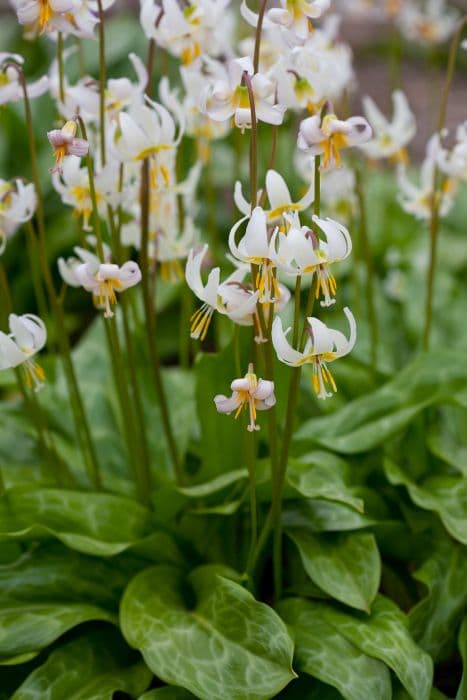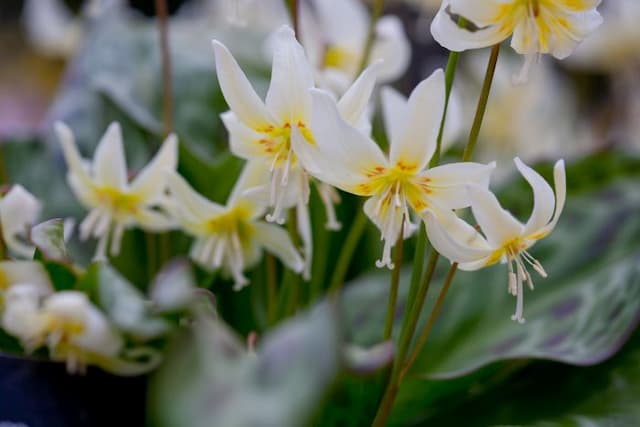Tulip Tulipa Albion Star = 'Mieke Telkamp' (13)
![tulip [Albion Star]](/_next/image?url=https%3A%2F%2Fplants-admin.emdemapps.com%2Fimages%2Fplants%2F%2Fimages%2F604b5b50b8511.png&w=3840&q=75)
ABOUT
The Tulipa Albion Star, commonly known as the Tulip 'Mieke Telkamp', is a visually striking plant that boasts large, cup-shaped flowers. The petals are predominantly white in color, with an attractive and delicate purple-pink edging that adds an elegant contrast. Inside the flower, the base typically shows a yellowish hue that gently merges with the predominating white. This region often exhibits a darker coloration that gives way to the lighter petals. These blooms are held proudly atop sturdy stems which are nestled amongst a lush greenery of pointed leaves. The foliage is a classic tulip green, sometimes presenting a glaucous or waxy appearance that adds to the overall fresh look of the plant. The leaves are elongated, with a somewhat lance-shaped appearance, and tend to arch elegantly, further accentuating the proud stance of the blooms above. The Tulip 'Mieke Telkamp' has a symmetrical form that provides a clean and sleek profile. The flower's appearance exudes a certain degree of opulence, making this plant a sought-after choice for gardens and floral displays. It is typically enjoyed for its bold yet sophisticated color palette, which often heralds the arrival of spring when it begins to bloom.
About this plant
 Names
NamesFamily
Liliaceae.
Synonyms
Tulip.
Common names
Tulipa 'Mieke Telkamp'
 Toxicity
ToxicityTo humans
Tulips are not significantly toxic to humans, but they can cause mild irritation to the skin or digestive system if ingested in large quantities. Symptoms might include nausea, vomiting, or diarrhea, although serious cases are rare since these plants are not usually consumed in large amounts due to their unpleasant taste.
To pets
Tulips can be toxic to cats and dogs if ingested. The most toxic part of the plant is the bulb. Symptoms of tulip poisoning in pets can include vomiting, diarrhea, drooling, and in severe cases, an increased heart rate and changes in breathing. If you suspect your pet has ingested tulip bulbs, it is important to contact your veterinarian immediately.
 Characteristics
CharacteristicsLife cycle
Perennials
Foliage type
Deciduous
Color of leaves
Green
Flower color
White
Height
1-2 feet (30-60 cm)
Spread
0-1 feet (0-30 cm)
Plant type
Bulb
Hardiness zones
3
Native area
Central Asia
Benefits
 General Benefits
General Benefits- Enhances Garden Aesthetics: Tulips add vibrant color and visual interest to gardens and landscapes.
- Easy to Grow: They are user-friendly for beginners and require minimal maintenance once established.
- Spring Bloom: They herald the arrival of spring with their early and colorful flowers.
- Good for Cut Flowers: Tulips are ideal for creating beautiful floral arrangements and bouquets.
- Attracts Pollinators: Tulips can attract bees and other beneficial pollinators, helping to maintain a healthy ecosystem.
- Variety: With many different colors and shapes available, tulips provide gardeners with numerous design options.
 Medical Properties
Medical PropertiesThis plant is not used for medical purposes.
 Air-purifying Qualities
Air-purifying QualitiesThis plant is not specifically known for air purifying qualities.
 Other Uses
Other Uses- Tulips can be used in fashion design, where their petals are pressed and incorporated into fabric patterns for a unique botanical touch.
- In photography, Tulips serve as exquisite subjects for macro photography, capturing the intricate patterns and colors of their petals.
- Dried Tulip petals can be used in crafting homemade paper, giving the paper a delicate texture and floral scent.
- As an educational tool, Tulips can be dissected in biology classes to teach students about the anatomy of flowering plants.
- In culinary arts, Tulip petals, being edible, can be candied for decorative dessert toppings or incorporated into salads for a splash of color.
- Tulips can inspire artworks and be used in painting classes as still life subjects for students to capture their vibrant hues.
- They can be used in perfumery, by distilling essential oils from the petals to create floral-based scents.
- As part of an eco-friendly burial, biodegradable Tulip bulbs could be planted on graves as a sustainable, living tribute to loved ones.
- In home decor, dried Tulips can be used to create natural and rustic wreaths or arrangements.
- Used in landscape design, specifically in the practice of color theory, where they help in creating a visual impact through their bold colors and seasonal blooms.
Interesting Facts
 Feng Shui
Feng ShuiThe Tulip is not used in Feng Shui practice.
 Zodiac Sign Compitability
Zodiac Sign CompitabilityThe Tulip is not used in astrology practice.
 Plant Symbolism
Plant Symbolism- Love: The Tulip is often associated with deep love. The iconic shape and array of colors express the perfect, enduring love between partners or family members.
- Perfect Lover: In Persian mythology, it's said that the tulip was born from the droplets of blood of a perfect lover, reinforcing its symbol for true love.
- Rebirth: As a herald of spring, tulips are symbolic of rebirth and renewal due to their seasonality, popping up from the ground as one of the first blooms of the season.
- Charity: The Albion Star Tulip can represent charity. As a spring flower, the tulip's cycle of growth and return each year can be synonymous with consistent giving and altruism.
- Fame and Eternal Life: In the context of historical Turkey and Persia, tulips had been associated with fame and eternal life, often depicted in tales of indulgence and splendor.
- Forgiveness: A white tulip, which this variety resembles, is especially linked with forgiveness, providing a means to apologize and mend relationships with simplicity and grace.
 Water
WaterTulips, including the 'Mieke Telkamp' variety, generally prefer to be watered deeply but infrequently, ensuring that the soil dries out somewhat between waterings to prevent bulb rot. During the active growing season, usually in the spring, water them thoroughly once a week with about an inch of water, which is approximately 0.6 gallons for a 10 square foot area. Post-bloom, as the foliage begins to die back, reduce watering gradually to allow the bulb to enter dormancy. If rainfall is sufficient, additional watering may not be necessary.
 Light
LightTulips like 'Mieke Telkamp' thrive in full sun but can tolerate some partial shade. Ideally, the bulbs should be planted in a location where they can receive at least six hours of direct sunlight daily, as this maximizes bloom quality and plant vigor. Avoid excessively shady locations, as this can lead to weak stems and sparse flowering.
 Temperature
TemperatureThe 'Mieke Telkamp' tulip can survive winter temperatures if the ground is not frozen solid, typically down to about -20 degrees Fahrenheit, and they can handle spring temperatures up to about 70 degrees Fahrenheit. They perform best in cool spring weather and can suffer in prolonged hot temperatures. The ideal temperature range for tulips is between 50 and 65 degrees Fahrenheit.
 Pruning
PruningPruning Tulips like 'Mieke Telkamp' primarily involves deadheading spent blooms to prevent the plant from putting energy into seed production. Remove the flower heads after they have wilted but leave the foliage intact until it turns yellow and dies back naturally, usually by late spring or early summer, to allow the bulbs to store energy for the next season.
 Cleaning
CleaningAs needed
 Soil
SoilThe best soil mix for the Tulip 'Albion Star', also known as 'Mieke Telkamp', should be well-draining and fertile, with a mix of loamy soil, compost, and sand to facilitate proper drainage. The soil pH for tulips is preferably neutral to slightly acidic, around pH 6.0 to 7.0.
 Repotting
RepottingTulips, including the 'Albion Star', do not require frequent repotting. They are typically planted as bulbs and can be left undisturbed in the soil for several years. Every 3-5 years, or when flowering diminishes, bulbs can be lifted, divided, and replanted to rejuvenate growth.
 Humidity & Misting
Humidity & MistingTulips, such as the 'Albion Star', prefer ambient outdoor humidity levels. They don’t have specific humidity requirements but perform best in outdoor environments where humidity is not excessively high.
 Suitable locations
Suitable locationsIndoor
Ensure cool temperature, bright indirect light.
Outdoor
Plant bulbs in fall, full sun to partial shade.
Hardiness zone
3-8 USDA
 Life cycle
Life cycleThe Tulipa 'Albion Star', commonly known as the tulip, begins its life cycle when a bulb is planted in the fall before the first frost. This bulb remains dormant until early spring, where it begins the germination process, leading to the emergence of shoots and leaves as temperatures rise. The plant continues to develop and eventually blooms, producing the characteristic colorful flowers which can last for several weeks. After flowering, the tulip enters a senescence phase, during which the petals fall off and the above-ground plant parts begin to die back. The energy is then redirected to the bulb, which stores nutrients and energy for the next growing season. Finally, the plant returns to dormancy throughout the summer and until the next fall, when the cycle can begin anew with the next generation of bulbs that may have developed from offsets.
 Propogation
PropogationPropogation time
Spring
The most popular method of propagating tulips, including the Tulipa 'Albion Star' which is also known as Tulip 'Mieke Telkamp', is by dividing the bulbs. This process is ideally done in the fall when the bulbs are dormant. The mature bulbs are carefully dug up from the ground and any offsets, which are small bulbs forming at the base of the parent bulb, are gently separated. These offsets can then be planted immediately at a depth about three times the height of the bulb, in well-draining soil with good exposure to sunlight. Ensuring appropriate spacing between the bulbs, typically around 4 to 6 inches (approximately 10 to 15 centimeters), allows for adequate root expansion and prevents overcrowding as the bulbs grow.








